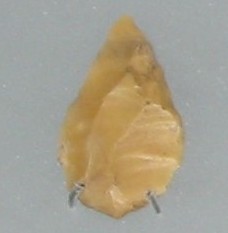Neolithic Arrowhead
02 February 2010
- News Type:
- Find of the Month
 This is an example of the classic type of Neolithic arrowhead, generally known as a leaf-shaped arrowhead for obvious reasons! They are generally dated to the earlier Neolithic, between 3800 and 2500 BC. This one was found at Tarbat, Portmahomack, but similar ones are found throughout Scotland and Britain. Arrows such as these were essential for hunting or warfare, but the bows or shafts almost never survive.
This is an example of the classic type of Neolithic arrowhead, generally known as a leaf-shaped arrowhead for obvious reasons! They are generally dated to the earlier Neolithic, between 3800 and 2500 BC. This one was found at Tarbat, Portmahomack, but similar ones are found throughout Scotland and Britain. Arrows such as these were essential for hunting or warfare, but the bows or shafts almost never survive.
Arrowheads were made by chipping away (knapping) cores of flint or other available stone, using the pressure flaking technique. Producing an arrowhead of this type required skill and patience. There are several possible production sites in the area, including at Cuthill Links near Dornoch. The SCRAN website contains a series of good videos showing how such arrowheads were made, and then how they were attached to the shafts. (Note that you need to be a subscriber to the full use of SCRAN to view the videos, so view at the Highland Council library if you are not.) A number of websites also have descriptions or videos showing how such arrowheads are made - just google flint knapping arrowheads.
Arrowheads from the Bronze Age are of a different form (barbed and tanged), so that a leaf-shaped arrowhead provides useful dating evidence when found.
Further Information:
This object is on display at the Tarbat Discovery Centre in Portmahomack, Easter Ross.
Most books describing the Neolithic in Scotland will discuss stone tools and arrowheads.
Find of the Month Archive
- 25/07/2022 Steatite Vessels
- 10/04/2021 Cruisie lamp in Dunrobin Castle Museum
- 02/03/2021 Medieval Sword Pommel from Sleat, Skye
- 01/02/2021 Hilton of Cadboll Pictish Cross Slab
- 04/01/2021 Gunflint from Stoneyfield, Inverness
- 02/12/2020 Bobbin from Contin Bobbin Mill
- 02/11/2020 Russian Lead Cloth Seal from Cromarty
- 01/10/2020 The Poolewe Hoard
- 04/09/2020 Storr Rock Viking Silver Hoard
- 07/08/2020 Mesolithic bloodstone artefacts from Camas Daraich, Skye
